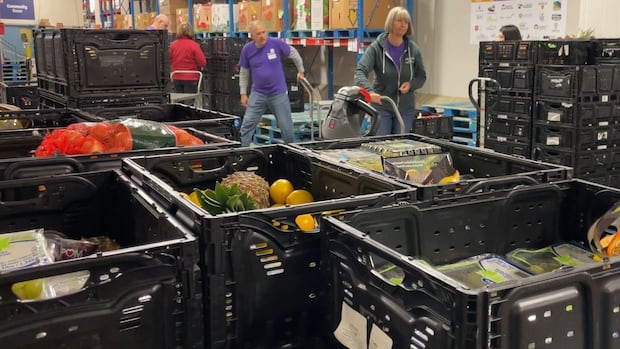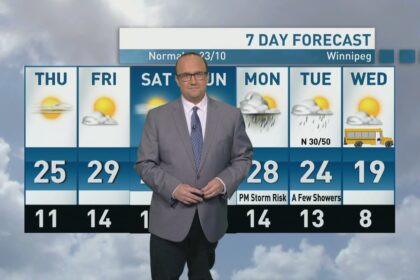Kitchener-Waterloo·NewThanksgiving weekend is a busy one for fall food banks, as ones in Ontario, for instance, aim to stock their shelves for the colder months. Advocates say more people are seeking community help to put food on the table. Here are ways people can help the efforts.CEO of Feed Ontario says ‘all actions can make a difference’ as fall food drives underwayKate Bueckert · CBC News · Posted: Oct 13, 2025 6:00 AM EDT | Last Updated: 32 minutes agoDonations from the public, like those made at grocery stores or company food drives, are placed in large cardboard bins, then sorted and stored in the warehouse at The Food Bank of Waterloo Region. The food bank reports that in September, they saw a seven per cent year-over-year increase in the number of people who needed food assistance. (Kate Bueckert/CBC)Food banks across Ontario are running their fall drives to keep up with demand from people in their communities, from individuals to families. Last year, the food banks served more than one million people, a record number.“This year, things have not gotten any better,” said Carolyn Stewart, chief executive officer of Feed Ontario, which represents a network of over 1,200 food banks and hunger relief organizations.“The affordability crisis that we’re also seeing is really still affecting Ontarians and leaving them unable to afford their most basic necessities, and this led to record high numbers of our neighbours turning to food banks for help.”Stewart said no matter whether people are in the province, they’re seeking services from food banks and other groups that help with hunger relief, and it’s not slowing down.“I think what we can all agree on is it’s been a really tough year, right? We’ve seen food prices continue to increase, housing continuing to be out of reach, and all these things are affecting all regions of the province.”Increase in Waterloo regionKim Wilhelm is CEO of The Food Bank of Waterloo Region, which works with a number of local organizations and groups to distribute food. She said the need for food assistance in the region “is higher than ever.”Kim Wilhelm is the CEO of The Food Bank of Waterloo Region. She says the network of organizations that distribute food in the community are seeing a significant increase in people needing help. (Josette Lafleur/CBC)“In September alone, our partners in the Community Food Assistance Network served nearly 26,000 adults and children, highlighting just how critical these programs are for individuals and families across our community,” she said. She noted the September numbers represented a seven per cent year-over-year increase. “As the weather gets colder, many families are feeling added pressure: higher heating bills, increased transportation costs, and the need for warm clothing and winter gear all stretch already tight budgets,” Wilhelm said. “With these extra expenses, it becomes even harder for people to afford food, and we expect the demand for support to keep rising. That’s why community support is so important right now.”Dianne McLeod, CEO of the Cambridge Food Bank, said they’re also seeing a shift in who needs food assistance.“We’re seeing more and more employed people accessing the food bank, people who are just finding that the money that they’re earning is not stretching as far, particularly at the grocery store,” she said.“Housing costs are rising exponentially for people who are renters and the one area that we’re seeing that people are cutting back on is food because they want to keep a roof over their head.”In London, Ont., the food bank’s fall drive focused on the need to feed children and youth.The food bank says 12,685 households, including 33,913 individuals, have used its services so far in 2025. Of those individuals, 40 per cent were children or youth.”Our society is failing our kids. London is failing our kids,” Glen Pearson, London Food Bank’s director, told CBC London.Volunteers work in the warehouse of The Food Bank of Waterloo Region. (Kate Bueckert/CBC)In September, Food Banks Canada released its annual report card and gave Canada a D grade, noting more than a quarter of all Canadians are struggling to get the food they need.Kirstin Beardsley, CEO of Food Banks Canada, told CBC Toronto that was a “shocking number.””What we’re seeing for low-income folks is that they’re spending well over 50 per cent of their incomes on rent alone, which gives them no financial resilience to meet challenges.”Ways to helpWilhelm said that for The Food Bank of Waterloo Region, donations like non-perishable foods, financial contributions, which the food bank can use to buy essential items, or even people who can volunteer some of their time is what they need most.“Whether someone donates food or funds, joins a community event, or lends a hand as a volunteer, every bit of support makes a difference,” she said.Stewart said just being aware of what the community is facing is also a good place to start. An online experience on the Feed Ontario website is called Fork in the Road, and helps people understand what it means to be someone in need.“It’s really about walking a day in a month in the shoes of people who are facing poverty, and the incredibly difficult choices that they have to face and see if you can get to the end of the month on such a limited budget,” she said. “It really helps to paint a picture of the challenges that people in Ontario are facing when dealing with poverty.”She said food banks in Ontario distribute more than seven million kilograms of food each year.“Every dollar donated to our organization, for example, we can provide two meals to someone in need,” she noted.“Volunteering is a great way. You know, 80 per cent of our network has five or fewer staff. That means volunteers are the engine power of food banks across the province,” she said.Stewart added that “big or small, all actions can make a difference.”ABOUT THE AUTHORKate is currently the content producer for CBC Kitchener-Waterloo. She has been covering issues in southern Ontario for more than 20 years. Reach her by email: kate.bueckert@cbc.ca.
Friday, 28 Nov 2025
Canada – The Illusion
Search
Have an existing account?
Sign In
© 2022 Foxiz News Network. Ruby Design Company. All Rights Reserved.
You May also Like
- More News:
- history
- Standing Bear Network
- John Gonzalez
- ᐊᔭᐦᑊ ayahp — It happened
- Creation
- Beneath the Water
- Olympic gold medal
- Jim Thorpe
- type O blood
- the bringer of life
- Raven
- Wás’agi
- NoiseCat
- 'Sugarcane'
- The rivers still sing
- ᑲᓂᐸᐏᐟ ᒪᐢᑿ
- ᐅᑳᐤ okâw — We remember
- ᐊᓂᓈᐯᐃᐧᐣ aninâpêwin — Truth
- This is what it means to be human.
- Nokoma












